American film actor Tom Mix (1880-1940) was the star of many Westerns between 1909 and 1935. He was Hollywood's first Western megastar and helped to define the genre for all cowboy actors who followed. Mix revolutionised the genre by eschewing realism in favour of more fantastical, lighthearted storylines and picturesque visual elements, like his clean, expensively tailored costumes. Mix appeared in 291 films, all but nine of which were silent.

German postcard by Ross Verlag, Berlin, no. 1025/3, 1927-1928. Photo: Fox-Film.

German postcard by Ross Verlag, no. 1025/4, 1927-1928. Photo: Fox-Film.
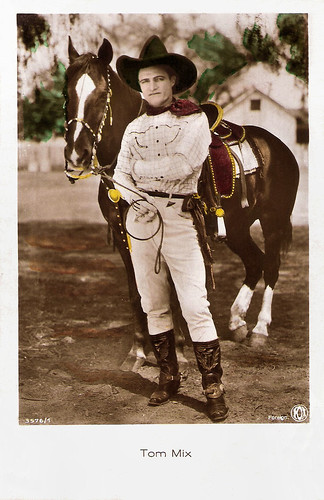
German postcard by Ross Verlag Foreign, no. 3576/1, 1928-1929. Photo: Fox.

German postcard by Ross Verlag, no. 3904/2, 1928-1929. Photo: Fox.

German postcard by Ross Verlag, no. 4405/4, 1929-1930. Photo: Fox.
Thomas Hezikiah Mix was born in Mix Run, Pennsylvania, in 1880. His parents were Edwin Mix and Elizabeth née Heistand. He grew up in nearby DuBois, Pennsylvania, where his father, a stable master for a wealthy lumber merchant, taught him to ride and love horses. Tom spent time working on a local farm owned by John DuBois, a lumber businessman. He had dreams of being in the circus and was rumoured to have been caught by his parents practising knife-throwing tricks against a wall, using his sister as an assistant.
In April 1898, during the Spanish–American War, he enlisted in the Army under the name Thomas E. (Edwin) Mix. His unit never went overseas. In 1902, he deserted the army to marry his first wife, Grace Allin. The marriage was annulled a year later. The fact that he was a deserter did not come up until after his death. Mix went to Oklahoma and lived in Guthrie, working as a bartender, a night marshal, and doing other odd jobs. From 1906 to 1909, he was in a series of Wild West shows, such as 'The Miller Bros. Wild West Show', with wife Olive Mix-Stokes in Seattle's 'Alaska-Yukon-Pacific Exposition', and Will A. Dickey's 'Circle D Ranch'.
The latter supplied the Selig Polyscope Company with cowboys and Indians for films, and, in 1910, Mix was hired by Selig to provide and handle horses. His first film was Ranch Life in the Great Southwest (Francis Boggs, 1910), according to Ed Stephan at IMDb, or The Cowboy Millionaire (Francis Boggs, Otis Turner, 1910), according to Wikipedia.
However, he appeared as himself in Ranch Life in the Great Southwest, in which he displayed his skills as a cattle wrangler. Shot at the Selig studio in the Edendale district of Los Angeles (now known as Silver Lake), the film was a success, and Mix became an early motion picture star. He performed in more than 100 films for Selig, many of which were filmed in Las Vegas, New Mexico. Mix continued with Selig until 1917, writing and directing as well as acting. While with Selig, he co-starred in several films with Victoria Forde, and they fell in love. He divorced Olive Stokes in 1917.
Tom Mix and Victoria Forde were signed by Fox Film Corporation in 1917, and he remained with them until 1928, averaging five films a year. His popularity eclipsed all other great cowboy stars, including Hoot Gibson and even the legendary William S. Hart, of the silent era. He earned - and spent - millions. He loved sports cars, wild parties, and fancy clothes. He owned a huge Hollywood mansion that had his name emblazoned above it in neon lights and had numerous ex-wives to support.

British postcard in the Cinema Stars Series by Lilywhite, no. C.M. 23. Photo: Fox.
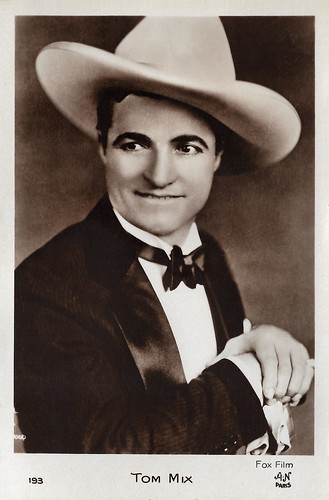
French postcard by A.N., Paris, no. 193. Photo: Fox Film.

French postcard. Photo: Fox Film.

French postcard by Cinémagazine-Edition, no. 183.
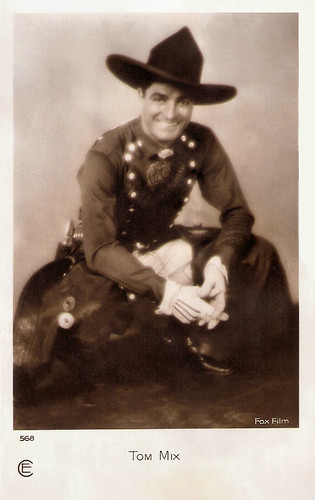
French postcard by Cinémagazine-Edition, no. 568. Photo: Fox Film.
Tom Mix was the king of the cowboys during the 1920s. At Fox, he developed a comical style, emphasising fast action thrills to a greater extent than had been common in earlier Westerns, and he did his own stunts. These featured action-oriented scripts contrasted with the documentary style of his work with Selig. In addition to Mix's riding and shooting skills, the films also showcased the talents of his intelligent and handsome horse, Tony. Heroes and villains were sharply defined, and a clean-cut cowboy always saved the day. Millions of American children grew up watching his films on Saturday afternoons.
In 1932, he married his fifth wife, Mabel Hubbell Ward. Universal Pictures approached him that year with an offer to perform in 'talkies', which included script and cast approval. He acted in nine films for Universal, but because of injuries he received while filming, he was reluctant to do any more. Mix then appeared with the Sam B. Dill circus, which he reportedly bought two years later, in 1935. Sound and encroaching middle age were not favourable to Mix. While Tom Mix was a great showman, the combination of the Depression and the high overhead of his travelling shows conspired against his success.
He left the film industry after the 15-episode serial, The Miracle Rider (B. Reeves Eason, Armand Schaefer, 1935), made for Mascot Pictures. It was a huge hit for the small studio, grossing over $1 million. Tom was married five times. His wives were Grace I. Allen (1902-1903; the marriage was annulled), Jewel 'Kitty' Perrine (1905-1907; divorced), Olive Mix (1909-1918; divorced), Victoria Forde (1918-1932; divorced) and Mabel Hubbell Ward (1932-1940; his death). He had two daughters, Ruth Mix with Olive Mix, and Thomasina Mix with Victoria Forde.
Tom Mix died in an auto accident in 1940. While driving his 1937 Cord Sportsman through the Arizona desert, he took a turn too fast, a large aluminium suitcase broke loose, and he broke his neck and his car plunged into a ravine. He was 60 years old. The ravine was later named 'The Tom Mix Wash' in his honour. At Tom Mix's funeral, Rudy Vallee sang 'Empty Saddles'. His funeral took place at the Little Church of the Flowers in Glendale, California, and was attended by thousands of fans and Hollywood personalities. Mix was interred in the Forest Lawn Memorial Park Cemetery.
Tom Mix had made over $6,000,000 during his career, but an extravagant lifestyle had sharply reduced his estate to a modest amount by the time he died. Mix remained popular on the radio and in comic books for more than a decade after his death. Of his 291 films, only about 10% were known to be available for viewing. The 1937 Fox vault fire lost most of the archive of his films made with Fox. For his contribution to the motion picture industry, Mix has a star on the Hollywood Walk of Fame at 1708 Vine Street. His cowboy boot prints, palm prints, and the hoof prints of his horse, Tony, are at Grauman's Chinese Theatre, at 6925 Hollywood Boulevard.
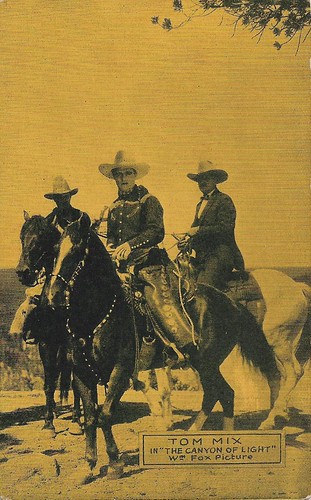
American postcard. Tom Mix on his horse Tony in The Canyon of Light (Benjamin Stoloff, 1926), shot in Glenwood Springs, Colorado. Photo: Fox Film. Co-actors were Barry Norton and Dorothy Dwan.

Probably an American collector card or postcard. Tom Mix and his horse Tony, posing.
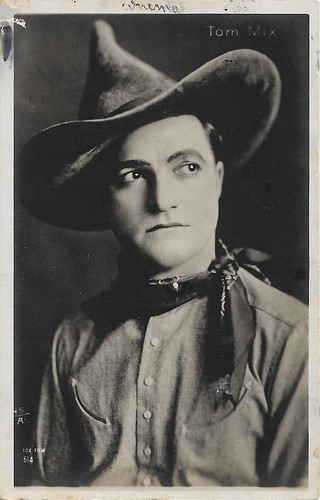
Italian postcard by Ed. G. Vettori, Bologna, no. 614.

Spanish card by EFB (Editorial Fotografica, Barcelona), no. A-22. Photo: Zerkowitz.

Spanish postcard. Photo: Albert Witzel.
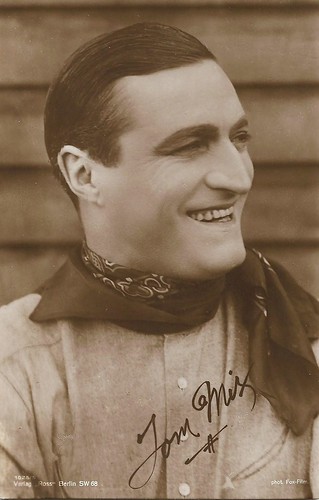
German postcard by Ross Verlag, no. 1025/5. Photo: Fox Film.

German postcard by Ross Verlag, Berlin, no. 3844/1, 1928-1929. Photo: Fox.

German postcard by Ross Verlag, no. 3844/3, 1928-1929. Photo: Fox Film.

German postcard by Ross Verlag, no. 4813/1, 1929-1930. Photo: Radio Pictures.

German postcard by Ross Verlag, no. 4813/2, 1929-1930. Photo: Radio Pictures Collection: Geoffrey Donaldson Institute.

German postcard by Ross Verlag, no. 5026/1, 1930-1931. Photo: Radio Pictures.

German postcard by Ross Verlag, no. 5026/2, 1930-1931. Photo: Radio Pictures.

German postcard by Ross Verlag, no. 5202/1, 1930-1931. Photo: Radio Pictures.
Tom Mix in Amsterdam and Berlin in 1925. Source: Eye Filmmuseum (YouTube).
Sources: Ed Stephan (IMDb), Wikipedia, and IMDb.
This post was last updated on 3 October 2025.

German postcard by Ross Verlag, Berlin, no. 1025/3, 1927-1928. Photo: Fox-Film.

German postcard by Ross Verlag, no. 1025/4, 1927-1928. Photo: Fox-Film.

German postcard by Ross Verlag Foreign, no. 3576/1, 1928-1929. Photo: Fox.

German postcard by Ross Verlag, no. 3904/2, 1928-1929. Photo: Fox.

German postcard by Ross Verlag, no. 4405/4, 1929-1930. Photo: Fox.
Earning and spending millions
Thomas Hezikiah Mix was born in Mix Run, Pennsylvania, in 1880. His parents were Edwin Mix and Elizabeth née Heistand. He grew up in nearby DuBois, Pennsylvania, where his father, a stable master for a wealthy lumber merchant, taught him to ride and love horses. Tom spent time working on a local farm owned by John DuBois, a lumber businessman. He had dreams of being in the circus and was rumoured to have been caught by his parents practising knife-throwing tricks against a wall, using his sister as an assistant.
In April 1898, during the Spanish–American War, he enlisted in the Army under the name Thomas E. (Edwin) Mix. His unit never went overseas. In 1902, he deserted the army to marry his first wife, Grace Allin. The marriage was annulled a year later. The fact that he was a deserter did not come up until after his death. Mix went to Oklahoma and lived in Guthrie, working as a bartender, a night marshal, and doing other odd jobs. From 1906 to 1909, he was in a series of Wild West shows, such as 'The Miller Bros. Wild West Show', with wife Olive Mix-Stokes in Seattle's 'Alaska-Yukon-Pacific Exposition', and Will A. Dickey's 'Circle D Ranch'.
The latter supplied the Selig Polyscope Company with cowboys and Indians for films, and, in 1910, Mix was hired by Selig to provide and handle horses. His first film was Ranch Life in the Great Southwest (Francis Boggs, 1910), according to Ed Stephan at IMDb, or The Cowboy Millionaire (Francis Boggs, Otis Turner, 1910), according to Wikipedia.
However, he appeared as himself in Ranch Life in the Great Southwest, in which he displayed his skills as a cattle wrangler. Shot at the Selig studio in the Edendale district of Los Angeles (now known as Silver Lake), the film was a success, and Mix became an early motion picture star. He performed in more than 100 films for Selig, many of which were filmed in Las Vegas, New Mexico. Mix continued with Selig until 1917, writing and directing as well as acting. While with Selig, he co-starred in several films with Victoria Forde, and they fell in love. He divorced Olive Stokes in 1917.
Tom Mix and Victoria Forde were signed by Fox Film Corporation in 1917, and he remained with them until 1928, averaging five films a year. His popularity eclipsed all other great cowboy stars, including Hoot Gibson and even the legendary William S. Hart, of the silent era. He earned - and spent - millions. He loved sports cars, wild parties, and fancy clothes. He owned a huge Hollywood mansion that had his name emblazoned above it in neon lights and had numerous ex-wives to support.

British postcard in the Cinema Stars Series by Lilywhite, no. C.M. 23. Photo: Fox.

French postcard by A.N., Paris, no. 193. Photo: Fox Film.

French postcard. Photo: Fox Film.

French postcard by Cinémagazine-Edition, no. 183.

French postcard by Cinémagazine-Edition, no. 568. Photo: Fox Film.
A horse called Tony
Tom Mix was the king of the cowboys during the 1920s. At Fox, he developed a comical style, emphasising fast action thrills to a greater extent than had been common in earlier Westerns, and he did his own stunts. These featured action-oriented scripts contrasted with the documentary style of his work with Selig. In addition to Mix's riding and shooting skills, the films also showcased the talents of his intelligent and handsome horse, Tony. Heroes and villains were sharply defined, and a clean-cut cowboy always saved the day. Millions of American children grew up watching his films on Saturday afternoons.
In 1932, he married his fifth wife, Mabel Hubbell Ward. Universal Pictures approached him that year with an offer to perform in 'talkies', which included script and cast approval. He acted in nine films for Universal, but because of injuries he received while filming, he was reluctant to do any more. Mix then appeared with the Sam B. Dill circus, which he reportedly bought two years later, in 1935. Sound and encroaching middle age were not favourable to Mix. While Tom Mix was a great showman, the combination of the Depression and the high overhead of his travelling shows conspired against his success.
He left the film industry after the 15-episode serial, The Miracle Rider (B. Reeves Eason, Armand Schaefer, 1935), made for Mascot Pictures. It was a huge hit for the small studio, grossing over $1 million. Tom was married five times. His wives were Grace I. Allen (1902-1903; the marriage was annulled), Jewel 'Kitty' Perrine (1905-1907; divorced), Olive Mix (1909-1918; divorced), Victoria Forde (1918-1932; divorced) and Mabel Hubbell Ward (1932-1940; his death). He had two daughters, Ruth Mix with Olive Mix, and Thomasina Mix with Victoria Forde.
Tom Mix died in an auto accident in 1940. While driving his 1937 Cord Sportsman through the Arizona desert, he took a turn too fast, a large aluminium suitcase broke loose, and he broke his neck and his car plunged into a ravine. He was 60 years old. The ravine was later named 'The Tom Mix Wash' in his honour. At Tom Mix's funeral, Rudy Vallee sang 'Empty Saddles'. His funeral took place at the Little Church of the Flowers in Glendale, California, and was attended by thousands of fans and Hollywood personalities. Mix was interred in the Forest Lawn Memorial Park Cemetery.
Tom Mix had made over $6,000,000 during his career, but an extravagant lifestyle had sharply reduced his estate to a modest amount by the time he died. Mix remained popular on the radio and in comic books for more than a decade after his death. Of his 291 films, only about 10% were known to be available for viewing. The 1937 Fox vault fire lost most of the archive of his films made with Fox. For his contribution to the motion picture industry, Mix has a star on the Hollywood Walk of Fame at 1708 Vine Street. His cowboy boot prints, palm prints, and the hoof prints of his horse, Tony, are at Grauman's Chinese Theatre, at 6925 Hollywood Boulevard.

American postcard. Tom Mix on his horse Tony in The Canyon of Light (Benjamin Stoloff, 1926), shot in Glenwood Springs, Colorado. Photo: Fox Film. Co-actors were Barry Norton and Dorothy Dwan.

Probably an American collector card or postcard. Tom Mix and his horse Tony, posing.

Italian postcard by Ed. G. Vettori, Bologna, no. 614.

Spanish card by EFB (Editorial Fotografica, Barcelona), no. A-22. Photo: Zerkowitz.

Spanish postcard. Photo: Albert Witzel.

German postcard by Ross Verlag, no. 1025/5. Photo: Fox Film.

German postcard by Ross Verlag, Berlin, no. 3844/1, 1928-1929. Photo: Fox.

German postcard by Ross Verlag, no. 3844/3, 1928-1929. Photo: Fox Film.

German postcard by Ross Verlag, no. 4813/1, 1929-1930. Photo: Radio Pictures.

German postcard by Ross Verlag, no. 4813/2, 1929-1930. Photo: Radio Pictures Collection: Geoffrey Donaldson Institute.

German postcard by Ross Verlag, no. 5026/1, 1930-1931. Photo: Radio Pictures.

German postcard by Ross Verlag, no. 5026/2, 1930-1931. Photo: Radio Pictures.

German postcard by Ross Verlag, no. 5202/1, 1930-1931. Photo: Radio Pictures.
Tom Mix in Amsterdam and Berlin in 1925. Source: Eye Filmmuseum (YouTube).
Sources: Ed Stephan (IMDb), Wikipedia, and IMDb.
This post was last updated on 3 October 2025.
No comments:
Post a Comment